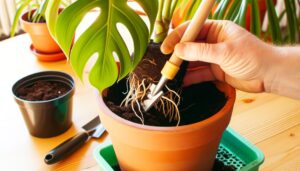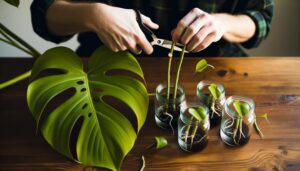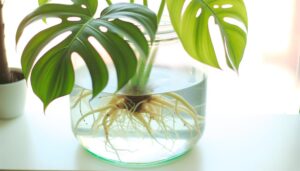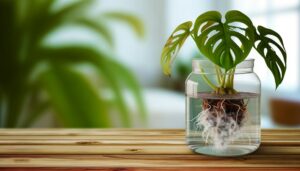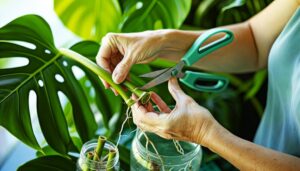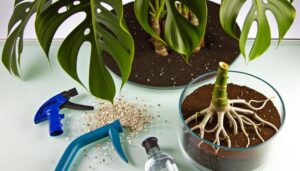How to Propagate Monstera From Seed? Complete Guide!
For successful Monstera propagation from seed, select fresh, healthy seeds and soak them in water for 24 hours. Use a well-draining potting mix and plant seeds shallowly.
Maintain a temperature range of 20-25°C and 60-70% humidity. Place seeds in bright, indirect light.
Expect germination within 2-4 weeks. Once seedlings outgrow the initial container, transplant them into individual pots.
Use balanced fertilizer and consistent watering. Protect seedlings from direct sunlight and monitor for pests.
Continue providing ideal conditions for thriving growth. Keep exploring to refine your Monstera propagation techniques further.
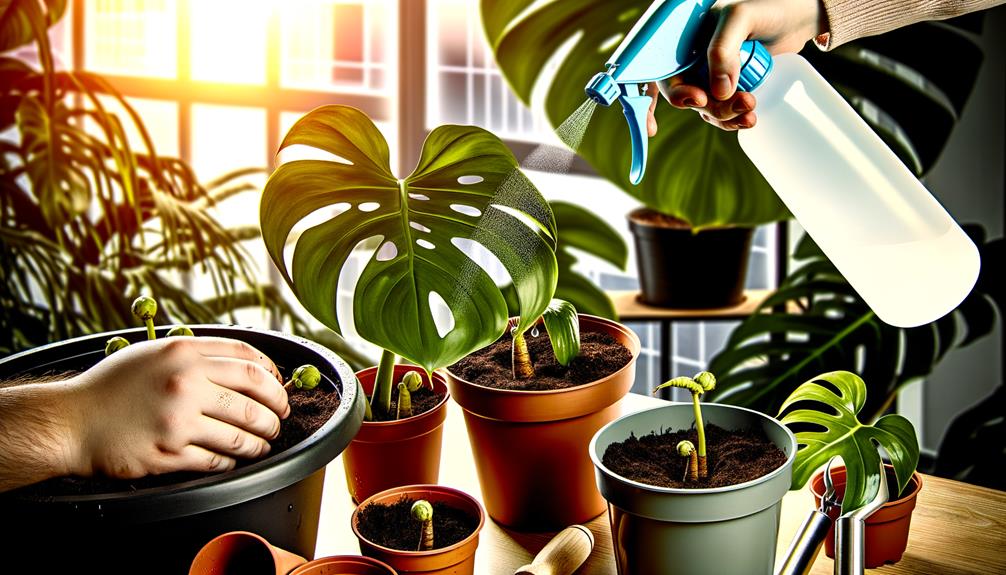
Key Takeaways
- Choose fresh, healthy Monstera seeds from reputable sources and avoid discolored or damaged seeds.
- Soak Monstera seeds in water for 24 hours before planting.
- Plant seeds in well-draining potting mix at a shallow depth and provide bright, indirect light.
- Maintain a temperature of 20-25°C and 60-70% humidity for optimal germination.
- Transplant seedlings into individual pots when they outgrow the initial container and ensure consistent watering and balanced fertilization.
Choosing Quality Monstera Seeds
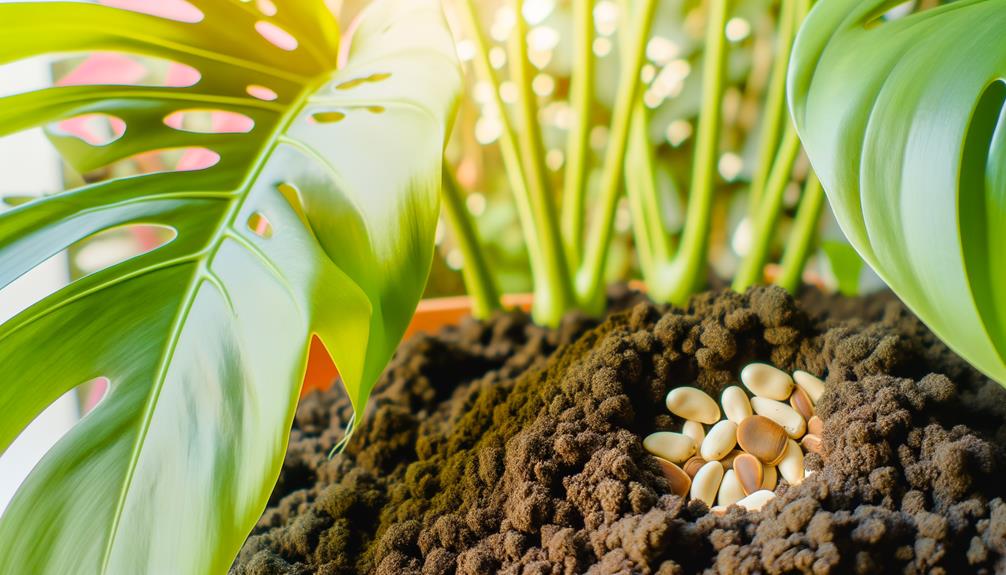
When selecting Monstera seeds, make certain they’re fresh, viable, and sourced from a reputable supplier to maximize germination rates. Fresh seeds increase the likelihood of successful germination.
Check the harvest date; seeds older than six months may have reduced viability. Confirm seeds are free from mold and pests, as these can impede germination.
Sourcing from reputable suppliers guarantees genetic integrity and minimizes the risk of receiving non-viable seeds.
Look for suppliers with positive reviews and transparent sourcing methods. You might want to verify if the supplier performs germination tests, which can provide data on expected germination rates.
Preparing Seeds for Germination
After securing high-quality Monstera seeds, the next step involves properly preparing them for germination to promote growth conditions.
Begin by soaking the seeds in lukewarm water (approximately 20-25°C) for 12-24 hours. This process helps soften the seed coat, enhancing water absorption and accelerating germination.
Post-soaking, transfer seeds to a paper towel and gently pat them dry to prevent fungal growth. Inspect each seed for potential damage or discoloration; discard any that appear compromised.
Utilize a sterilized seed tray with well-draining, nutrient-rich soil. Plant each seed about 1 cm deep, ensuring adequate spacing to avoid overcrowding.
Lightly mist the soil with water to maintain moisture levels, but avoid waterlogging, which can inhibit germination.
Creating the Ideal Environment

To create the ideal environment for Monstera seed propagation, you’ll need to maintain a temperature range of 20-25°C and a relative humidity of 60-70%.
Guarantee the seeds receive bright, indirect light and use a well-draining, porous soil mix.
These specific conditions will optimize germination and promote healthy seedling development.
Temperature and Humidity Control
Ideal temperature and humidity levels are essential for successfully propagating Monstera from seed. Maintain a consistent temperature range of 70-85°F (21-29°C) to optimize seed germination. Use a digital thermometer to monitor this.
For humidity, aim for 60-80%. A hygrometer will help you track this parameter. To uphold high humidity, place a clear plastic cover over the seed tray or use a humidity dome. Mist the seeds daily with a fine spray bottle to guarantee they remain moist but not waterlogged.
Avoid sudden temperature fluctuations and drafts, as these can hinder germination. Using a heat mat can provide consistent warmth, promoting faster growth. By regulating these environmental factors, you’ll create the ideal conditions for your Monstera seeds to thrive.
Light and Soil Requirements
Ensuring your Monstera seeds receive adequate light and are planted in well-draining soil is crucial for their successful germination and growth. Place your seeds in an area where they receive indirect sunlight for about 12-14 hours daily. Use fluorescent or LED grow lights if natural light is insufficient.
The soil should have a pH range of 5.5-7.0, rich in organic matter. A mix of peat moss, perlite, and orchid bark works well. Maintain soil moisture without waterlogging by watering when the top inch feels dry.
Consistent monitoring of light exposure and soil conditions will create an ideal environment for your Monstera seeds, ensuring robust growth and healthy development.
Sowing the Monstera Seeds
When sowing Monstera seeds, start by preparing a well-draining soil mix with a pH between 5.5 and 7.0.
Guarantee you plant the seeds at a depth of approximately 0.5 inches, lightly covering them with soil.
Maintain consistent moisture levels without saturating the soil to promote best germination.
Preparing the Soil
To prepare the soil for sowing Monstera seeds, mix equal parts of peat moss and perlite to guarantee proper drainage and aeration. This combination provides an ideal balance of moisture retention and soil structure.
Use a sterilized container to avoid contamination and create a disease-free environment. Fill the container with your soil mixture, leaving half an inch from the top for easy watering.
Moisten the soil evenly but avoid waterlogging, which can lead to seed rot. Utilize a spray bottle for controlled hydration. Ensure the soil temperature stays between 70°F and 85°F (21°C to 29°C) to promote germination. Employ a seedling heat mat if necessary.
Maintaining these conditions will improve the likelihood of successful seed propagation.
Planting Depth Guidelines
After preparing the soil, sow the Monstera seeds at a depth of 1/4 inch (0.6 cm) to secure ideal germination conditions. This depth guarantees that the seeds receive sufficient moisture while preventing them from being buried too deeply, which could impede sprouting.
Space the seeds approximately 2 inches (5 cm) apart to allow for best air circulation and root development. Cover the seeds lightly with soil, securing they’re fully enclosed but not compacted.
Maintain a consistent soil temperature of 70-75°F (21-24°C) and keep the medium moist but not waterlogged. Use a spray bottle for even moisture distribution. Regularly monitor the soil’s moisture level and temperature to secure the seeds germinate successfully within two to four weeks.
Caring for Germinating Seeds
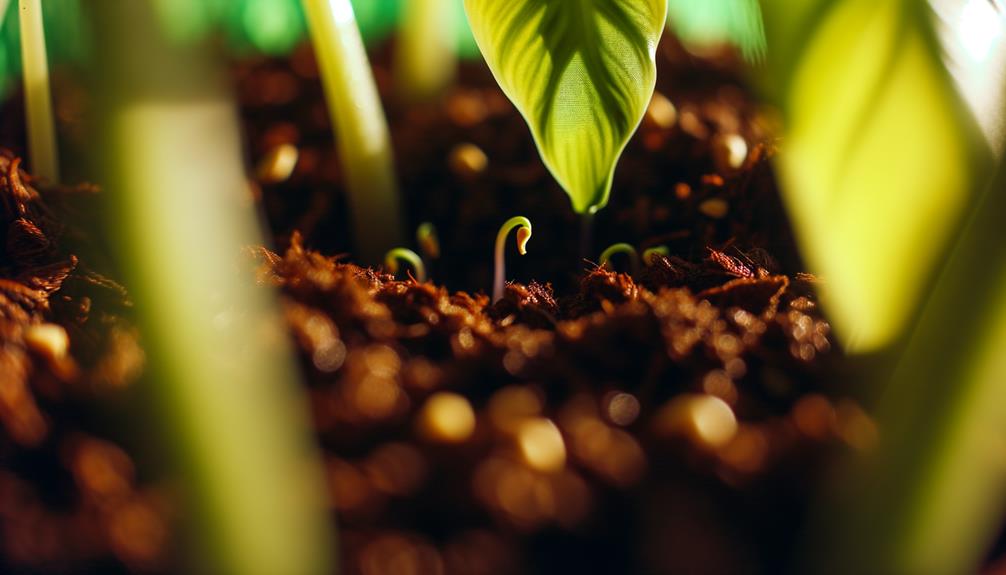
Fostering ideal moisture levels and consistent warmth is crucial for the successful germination of Monstera seeds. Aim for a temperature range of 70-75°F (21-24°C) to promote optimal conditions.
Use a humidity dome or plastic wrap to sustain 80-90% humidity. Check daily to confirm the medium remains moist but not waterlogged, as excessive moisture can lead to fungal growth. Utilize a spray bottle for even moisture distribution.
Monitor for signs of germination, which typically occurs within 2-4 weeks. Guarantee the seeds receive indirect light, avoiding direct sunlight that could cause overheating. Employ a heating mat if ambient temperatures are inconsistent.
Keep a close eye on soil conditions, maintaining a balance between moisture and aeration to support healthy seedling development.
Transplanting Seedlings
Once your Monstera seedlings have developed their first true leaves, it’s time to carefully transplant them into individual pots. Begin by selecting pots with a diameter of 4 inches and make sure they have adequate drainage.
Fill the pots with a well-draining potting mix, ideally containing perlite or orchid bark. Gently remove each seedling from its initial container, being cautious not to damage the roots. Place the seedling in the new pot, making certain the root ball is covered and the seedling is upright. Water thoroughly to settle the soil.
Here’s a quick guide:
| Step | Description |
|---|---|
| Select Pots | Use 4-inch pots with drainage holes |
| Prepare Soil | Use well-draining mix with perlite/orchid bark |
| Transplant | Gently transfer seedlings, avoid root damage |
| Water | Water thoroughly to settle soil |
This methodical approach guarantees healthy growth and minimal transplant shock.
Nurturing Mature Plants
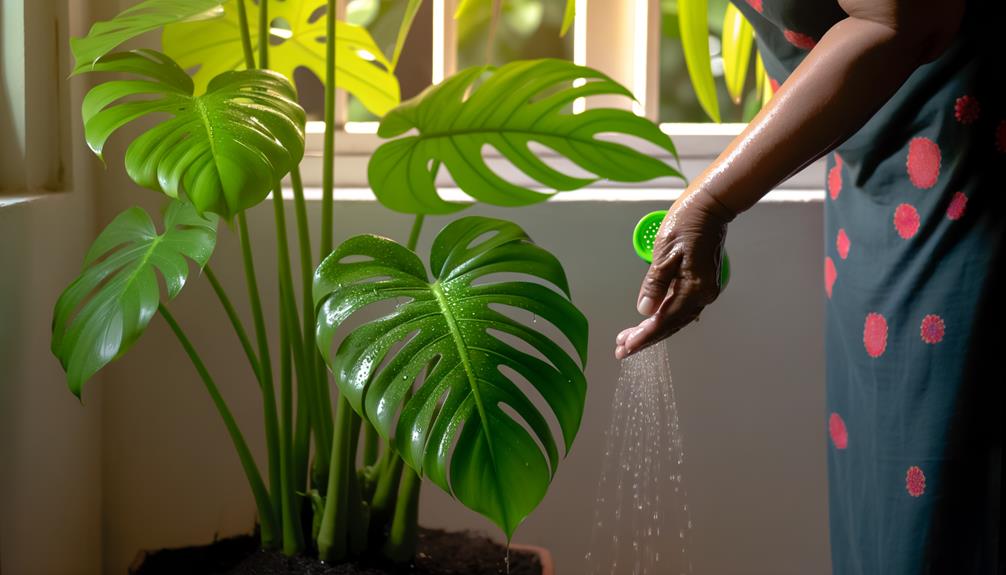
To nurture mature Monstera plants, make certain they receive indirect sunlight and maintain a consistent watering schedule to promote ideal growth. Place them in a location with filtered light, avoiding direct sunlight that can scorch leaves.
Water when the top 2-3 inches of soil are dry, guaranteeing proper drainage to prevent root rot. Aim for a humidity level of 60-70%, using a humidifier or pebble tray if necessary.
Fertilize monthly during the growing season with a balanced 20-20-20 NPK fertilizer. Monitor for pests like spider mites and scale insects, treating immediately with insecticidal soap.
Regularly prune dead or yellowing leaves to encourage new growth. These steps will make certain your Monstera thrives and reaches its full potential.
Conclusion
You’ve thoroughly cultivated your own Monstera from seed. By selecting quality seeds, preparing them properly, and creating an ideal environment, you’ve set a solid foundation.
Sowing the seeds and tending to germination stages guarantees success. Transplanting seedlings and nurturing mature plants completes this meticulous approach.
Remember, patience and accuracy pay off in propagation. With consistent care, your Monstera will thrive, forming fabulous foliage, and adding an alluring aesthetic to your space.
Happy growing!

